Switzerland study targets two specific mechanical energy conditions
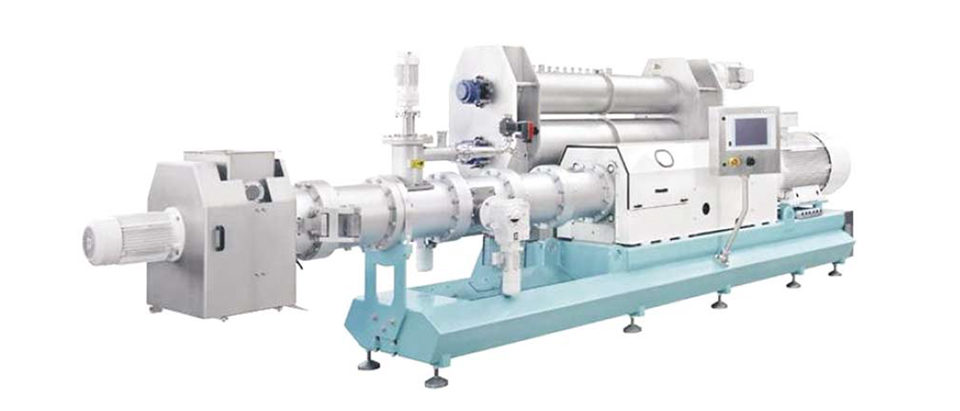
Today, most shrimp feed manufacturers use traditional pellet presses equipped with preconditioners with long residence times and post-pellet cooking units. Starch gelatinization in these units can reach 40 to 55 percent using a pre-conditioner with short residence time, and as high as 68 percent when a double- or triple-pass pre-conditioner is used in conjunction with a post-cooking unit.
Increasing starch gelatinization improves water stability. However, the degree of starch gelatinization has been assumed to be the sole reason for improvements in pellet water stability.
Extruded shrimp feeds
Several investigators and shrimp feed-manufacturing companies have used high-shear extruders with the understanding that the high degree of gelatinization obtained would improve pellet water stability. This resulted in the use of expanders, combinations of expanders and pelleting, and even double-pelleting setups.
A lot of money was spent on these technologies with limited results. The authors believe the industry should look closer at other extrusion technologies that use high moisture, very low shear, and low-temperature drying. The pasta industry provides a good example. Spaghetti is basically a long pellet and, if broken into pieces and placed in water at ambient temperature, it exhibits very long water stability.
However, the cold-extrusion process is at the low end of the scale, and for the reasons explained in the previous column, an optimum range of energy input is required to produce shrimp feed pellets that are soft enough for shrimp to shred, yet remain stable for four or more hours after being submerged.
Feed stability study
During April, the authors carried out a study at the Buhler Extrusion Research facility in Uzwil, Switzerland, to determine the effects of specific mechanical energy (SME) on the water stability of shrimp feeds. A twin-screw extruder equipped with SME and density control valves was used. No artificial binder was included in the feed formula, but a commercial binder was included in the same formula used for pelleting.
In the pelleting process, a PPC formula was subjected to a long-residence pre-conditioner (2.5 minutes at 90 degrees-C) and post-conditioning for 15 minutes at 90 degrees-C. A PPO mix was also processed in a long-residence preconditioner, but did not receive postpellet cooking.
For the study, two SME conditions were targeted: low (LSME, 90 kilojoules per kilogram) and medium (MSME, 126 kilojoules per kilogram). The extruded pellets were immediately cooled and therefore not subjected to any postcooking.
The pellets produced in each cell were subjected to a 30-minute water stability test using an orbital shaker, placed on a screen, and thoroughly washed to remove any fine particles. The remaining material was placed in a forced-air oven to dry. At the end of the drying period, the dried pellets were weighed, with the amount remaining (corrected for moisture content) divided by initial weight and multiplied by 100 to obtain the water stability percentage. A pellet durability test was also done to determine differences in pellet hardness between regular and extruded pellets.
Water stability
The data indicated that the pellets produced at low shear (LSME) and medium shear (MSME) had better water stability than pellets produced with the pellet mill for either treatment (PPC and PPO).
The PPC pellets had acceptable water stability greater than 80 percent after the 30-minute test, which correlated well with four-hour water stability. However, the PPO pellets had the lowest water stability, which could be mainly attributed to the lack of a postcooking treatment and not the binder. Pellets subjected to post-cooking showed a considerable improvement in water stability when compared to pelleting alone, even in formulas that contained a commercial binder.
Starch gelatinization
The starch gelatinization of pellets produced under treatment MSME was higher than for the low-shear conditions. However, water stability appeared to decrease with increasing SME. This could be attributed to the higher shear of the former treatment, which increased the water solubility of the pellets.
In this trial, the energy input at the MSME conditions was not high enough to cause a considerable reduction in water stability, which could have been expected when the energy input was above 250 kilojoules per kilogram, or roughly 70 watt-hour per kilogram. The energy input to the material was controlled by the moisture content added, screw configuration (in this study, the SME valve), screw speed, and feed rate. All these had a direct impact on the amount of working done to the meal.
Another way to assess the work done to the starch fraction is via rapid visco analyzer (RVA). With RVA, the viscosity of the starch phase can be measured when it is cold, and when it is heated and allowed to cool (set-back viscosity). This measurement of degree of cook can be used in extrusion processes to correlate starch gelatinization with thermomechanical cooking, and in turn, water absorption and solubility, and pellet water stability.
A study done by Lefuevrell in which RVA was used to measure starch damage showed that low-shear screw profiles with forward conveying, no reverse elements, and low screw speed produced less starch damage than screw profiles with reverse elements running at higher screw speeds.
Pellet hardness, physical integrity
There was no difference in pellet durability index, a measure of pellet hardness, for any of the pellets produced. Therefore, pellet hardness could not be directly correlated with pellet water stability.
Fig. 1 shows that pellets produced under the LSME conditions held their physical integrity after being submerged in water four hours. Pellets produced in treatment MSME had longitudinal cracks after four hours (Fig. 2). In Fig. 3, it is clear that after four hours of immersion, the extruded pellets (E) produced under low energy input had better water stability than those pelleted using a pellet mill (P).
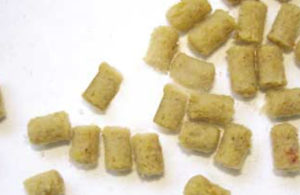
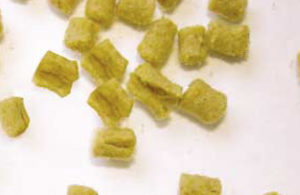

Further research
The study showed that pellets produced with an extruder with an SME control valve had improved water stability. However, other aspects remain to be evaluated, including the effects of the extrusion process using the SME control valve on feed-conversion ratios, nutrient leaching, and the digestibility of some less traditional ingredients. The environmental impacts of low-leaching, high-stability extruded feeds should also be evaluated.
Other extrusion advantages
Low mechanical energy input improves the water stability of shrimp formulas that do not contain binders. Using a twin-screw extruder with a SME control valve improves the water stability of pellets, and in addition, the versatility of the equipment allows the operator to dial optimal processing conditions at start-up in a few seconds. Therefore, shrimp feeds with targeted quality attributes can be produced in a shorter time.
Because twin-screw extruders are efficient pumps, the surging and blockages observed in pelleting at high moistures are nonexistent, which improves production efficiencies. The twin-screw technology with SME control permits the production of more-uniform pellet lengths and smaller pellet diameters that do not require particle size classification. Extruded feeds are also produced at high temperatures and pressures that destroy pathogenic organisms.
(Editor’s Note: This article was originally published in the August 2005 print edition of the Global Aquaculture Advocate.)
Now that you've reached the end of the article ...
… please consider supporting GSA’s mission to advance responsible seafood practices through education, advocacy and third-party assurances. The Advocate aims to document the evolution of responsible seafood practices and share the expansive knowledge of our vast network of contributors.
By becoming a Global Seafood Alliance member, you’re ensuring that all of the pre-competitive work we do through member benefits, resources and events can continue. Individual membership costs just $50 a year.
Not a GSA member? Join us.
Author
-

Eugenio Bortone, Ph.D., PAS, Dpl. ACAN
1521 Country Club Drive
Red Bay, Alabama 35582 USA[109,111,99,46,108,111,97,64,101,110,111,116,114,111,98,114,100]
Tagged With
Related Posts
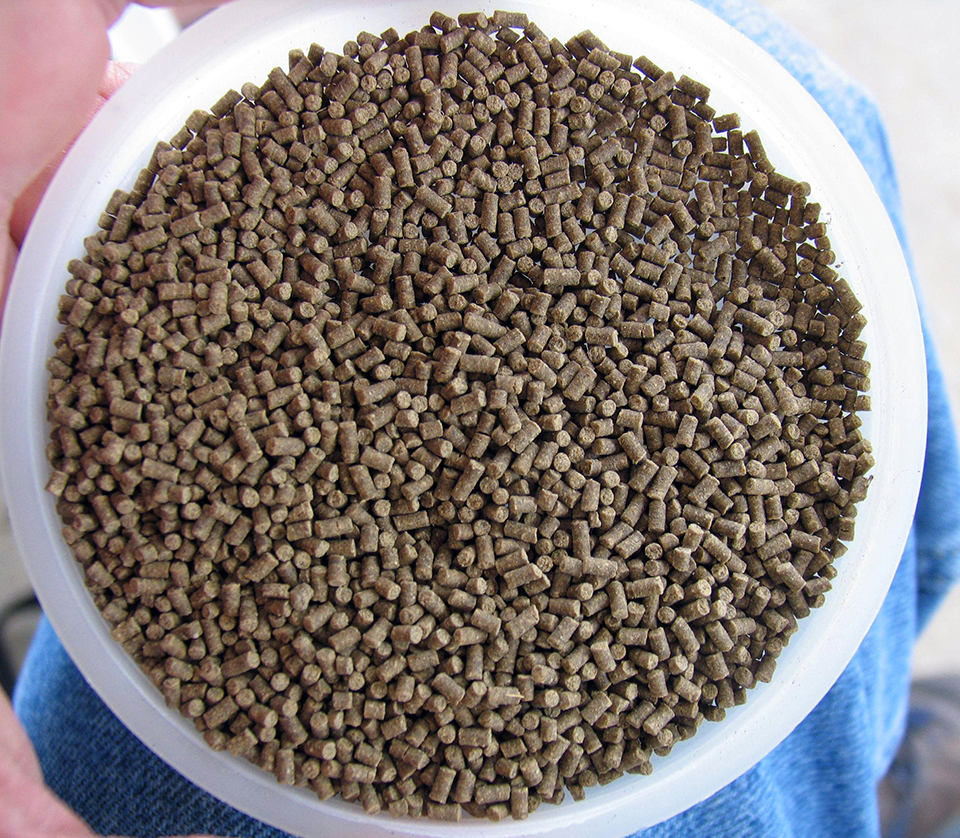
Health & Welfare
A case for better shrimp nutrition
Shrimp farm performance can often be below realistic production standards. Use proven nutrition, feeds and feeding techniques to improve profitability.

Responsibility
A look at integrated multi-trophic aquaculture
In integrated multi-trophic aquaculture, farmers combine the cultivation of fed species such as finfish or shrimp with extractive seaweeds, aquatic plants and shellfish and other invertebrates that recapture organic and inorganic particulate nutrients for their growth.

Aquafeeds
A look at protease enzymes in crustacean nutrition
Food digestion involves digestive enzymes to break down polymeric macromolecules and facilitate nutrient absorption. Enzyme supplementation in aquafeeds is a major alternative to improve feed quality and nutrient digestibility, gut health, compensate digestive enzymes when needed, and may also improve immune responses.
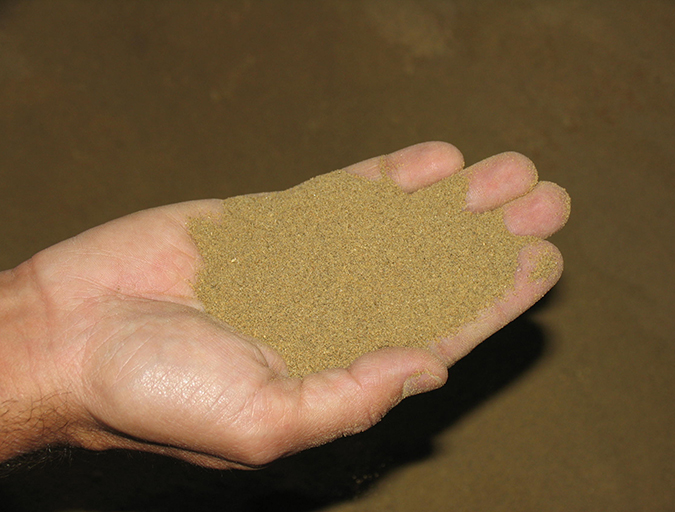
Aquafeeds
A look at the SME controlled extrusion process
A study was conducted using a Twin-Screw Extruder equipped with Specific Mechanical Energy (SME) and Density Control valves, to determine the effect of SME on the water stability of shrimp feeds. Further research is needed to evaluate the performance.

